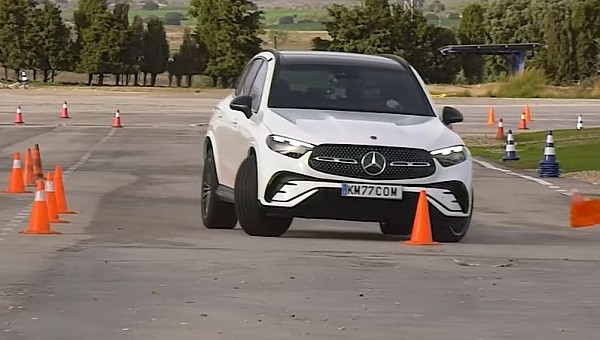Previously known as GLK, the Mercedes-Benz GLC rolled out in 2015 for the 2016 model year as the German brand’s compact luxury utility vehicle. The first generation was based on the MRA modular rear architecture, a platform that M-B thoroughly revised for the second-generation GLC.
Codenamed X254, the Gelandewagen Luxus Compact has been recently tested by Spanish publication km77 in two very telling scenarios. First things first, the slalom test evaluates the vehicle’s ability to negotiate equally-spaced cones arranged in a straight line. The faster it clears those cones, the better. As for the moose test, more steering input and higher speeds aim to measure the ability to avoid hitting an obstacle. Why is the moose test an industry standard?
Not only does it evaluate the stability of a given vehicle during a violent change of direction, but it also reveals how well the onboard safety tech works. In particular, it shows how good or bad the electronic stability control does its job. In the case of the GLC, understeer is the name of the game. Despite calling itself km77, the Spanish publication couldn’t go faster than 75 kilometers per hour (46.6 miles per hour) without the front bumper munching on at least a cone.
The driver gives credit where it’s due, though, highlighting that the rear end remained stable at all times and that none of the wheels came off the ground. Part of the reason the GLC didn’t fare better comes down to the 255/45 R20 and 285/40 R20 rubber. The Continental EcoContact 6 isn’t a high-performance tire, and in cold weather, such as on test day, the rubber certainly wasn’t at the right temperature either.
Equipped with 4MATIC all-wheel drive, the white-painted 220 d in the clip below sadly doesn’t impress in the slalom test. The weight of the vehicle is pretty noticeable with each change of direction, and the comfort-oriented steering isn’t anything to write home about either. On the upside, the stability and traction control system didn’t interfere too much, allowing the driver to feel in control at all times.
The slalom was dealt with in 24.8 seconds, which seems like an arbitrary number without a reference time. That reference time is 22.8 seconds for the Polestar 2 Long Range Dual Motor Performance Pack, which is heavier than the GLC 220 d 4MATIC. Bear in mind that the near-instant torque delivery of an electric vehicle does help in this situation.
When it comes to ICE reference times, let’s just say that both the Honda HR-V and Kia Niro needed 24.6 seconds. There is no denying the upcoming 63-series AMG will fare better in both the slalom and moose test, but as you may have probably heard by now, it’s not going to be a V8.
Similar to the C-Class on which it’s based, the GLC now comes exclusively with four cylinders. The 63 series gets plug-in assistance, and in the case of the C 63 S E Performance, it also sports the world’s most powerful four-cylinder engine designed for series-production applications. At full song, the most powerful C-Class of the lot makes 671 ponies and 752 pound-feet (1,020 Nm).
Not only does it evaluate the stability of a given vehicle during a violent change of direction, but it also reveals how well the onboard safety tech works. In particular, it shows how good or bad the electronic stability control does its job. In the case of the GLC, understeer is the name of the game. Despite calling itself km77, the Spanish publication couldn’t go faster than 75 kilometers per hour (46.6 miles per hour) without the front bumper munching on at least a cone.
The driver gives credit where it’s due, though, highlighting that the rear end remained stable at all times and that none of the wheels came off the ground. Part of the reason the GLC didn’t fare better comes down to the 255/45 R20 and 285/40 R20 rubber. The Continental EcoContact 6 isn’t a high-performance tire, and in cold weather, such as on test day, the rubber certainly wasn’t at the right temperature either.
Equipped with 4MATIC all-wheel drive, the white-painted 220 d in the clip below sadly doesn’t impress in the slalom test. The weight of the vehicle is pretty noticeable with each change of direction, and the comfort-oriented steering isn’t anything to write home about either. On the upside, the stability and traction control system didn’t interfere too much, allowing the driver to feel in control at all times.
The slalom was dealt with in 24.8 seconds, which seems like an arbitrary number without a reference time. That reference time is 22.8 seconds for the Polestar 2 Long Range Dual Motor Performance Pack, which is heavier than the GLC 220 d 4MATIC. Bear in mind that the near-instant torque delivery of an electric vehicle does help in this situation.
When it comes to ICE reference times, let’s just say that both the Honda HR-V and Kia Niro needed 24.6 seconds. There is no denying the upcoming 63-series AMG will fare better in both the slalom and moose test, but as you may have probably heard by now, it’s not going to be a V8.
Similar to the C-Class on which it’s based, the GLC now comes exclusively with four cylinders. The 63 series gets plug-in assistance, and in the case of the C 63 S E Performance, it also sports the world’s most powerful four-cylinder engine designed for series-production applications. At full song, the most powerful C-Class of the lot makes 671 ponies and 752 pound-feet (1,020 Nm).









